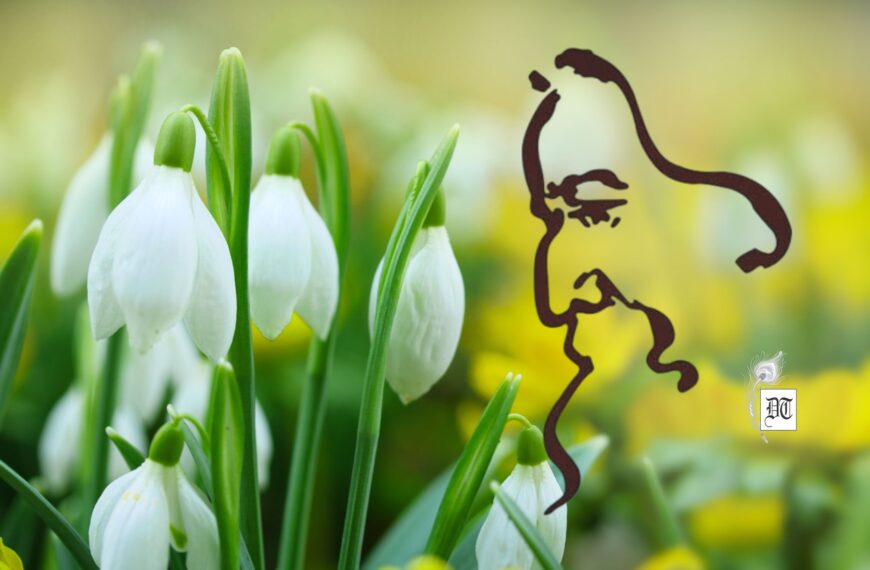Abstract art, a dynamic and influential expression, utilises non-representational elements like line, shape, colour, and texture to evoke emotions and ideas, elucidates Saptarptarshi in an exclusive for Different Truths.
Abstract art is a form of artistic expression that has gained significant recognition and relevance in contemporary art. Departing from representational art, abstract art pushes the boundaries of traditional artistic practices by focusing on non-representational imagery and emphasizing elements such as colour, shape, line, and texture This article aims to explore the basic concepts of forms, characteristics, techniques, elements, notable artists, impact, and significance of abstract art
The world of contemporary art is a vast and diverse sphere. and one of its most intriguing and captivating forms is abstract art. Abstract art, also known as non-representational art, moves away from the depiction of tangible objects and instead delves into the realm of emotions, ideas, and expressions. It is a departure from traditional art forms that aim to imitate reality, creating a unique language that speaks directly to the soul. Abstract Art takes various forms, each with its distinct style and approach. Some of the most prominent forms of abstract art include geometric abstraction, where shapes and patterns take center stage; lyrical abstraction, which evokes a sense of movement and rhythm; and colour field painting, where vast swathes of colour create a meditative experience.
The main characteristic of abstract art lies in its ability to evoke emotions.
The main characteristic of abstract art lies in its ability to evoke emotions, challenge conventional notions of representation and provide limitless space for interpretation. Abstract art celebrates the freedom of the artist’s hand, allowing them to explore the depths of their imagination and create a visual language devoid of constraints.
Abstract art can be defined as a departure from representational or figurative art. Instead of attempting to depict recognisable objects or scenes, abstract artists seek to convey emotions and ideas through non-representational imagery. This form of artistic expression emerged during the early 20th century with pioneers such as Wassily Kandinsky and Kazimir Malevich leading the way.
Kandinsky believed that colours had inherent spiritual qualities and sought to create artworks that evoked an emotional response in viewers.
There are various forms or styles within abstract art that showcase different approaches to this artistic practice.
There are various forms or styles within abstract art that showcase different approaches to this artistic practice. Geometric abstraction focuses on precise geometric shapes while gestural abstraction highlights spontaneous brushstrokes that express emotion or movement. Colour field painting explores large fields of flat colour without any reference to recognisable objects.



Each form has its own characteristics and unique features. Geometric abstraction often employs clean lines, sharp angles, and symmetry to create a sense of order and balance in the composition. Artists like Piet Mondrian utilised primary colours along with black horizontal and vertical lines to achieve visual harmony in their works.
Gestural abstraction emphasises expressive brushwork where artists use energetic strokes or drips of paint…
Gestural abstraction emphasises expressive brushwork where artists use energetic strokes or drips of paint to convey their inner emotions onto the canvas. Jackson Pollock’s famous ‘drip paintings’ embody this style as he allowed paint to flow freely from his brushes onto a horizontally placed canvas.
Colour field painting relies heavily on the colour itself rather than other visual elements like line or shape for its impact on viewers’ experience. Mark Rothko’s large-scale canvases with their immersive blocks of colour exemplify this style. Rothko believed that colour had the power to evoke spiritual and emotional responses in viewers, and his paintings invite contemplation and introspection.
The key characteristics of abstract art lie in its departure from representation and emphasis on non-representational imagery. Abstract art is not concerned with realistically depicting objects or scenes; instead, it focuses on the visual language of shape, line, colour, texture, and form. By removing the constraints of representation, abstract artists have the freedom to explore new ways of expressing themselves and pushing artistic boundaries.
Techniques used by abstract artists vary widely depending on their individual preferences and intentions. Some artists may pour or drip paint onto a canvas to create spontaneous marks or textures. Others may layer different materials or use unconventional tools for mark-making. These techniques allow artists to experiment with creating unique visual effects that enhance the overall composition.
Kazimir Malevich’s ‘Black Square’ (1915) is a seminal example of suprematism…
Kazimir Malevich’s ‘Black Square’ (1915) is a seminal example of suprematism, an abstract art movement that embraces geometric simplicity and focuses on the spiritual aspects of art. Jackson Pollock’s ‘No. 5, 1948’ is a prime illustration of action painting, where his iconic dripping and pouring techniques create a dynamic composition that seems to pulsate with energy.
Renowned artists who have employed various techniques in their abstract artworks include Jackson Pollock with his action painting technique involving drops and drips of paint onto horizontally placed canvases; Helen Frankenthaler who developed a soak-stain technique where she poured thinned paints directly onto unprimed canvas and Gerhard Richter who uses squeegees to scrape layers of paint across large-scale canvases.
Wassily Kandinsky’s ‘Composition VII’ showcases his mastery of geometric abstraction, as the canvas is filled with interlocking shapes and vibrant colours. Yayoi Kusama, a Japanese artist, is famous for her mesmerizing and immersive installations that incorporate repetitive patterns and vibrant colours. Her works often explore themes of infinity and obliteration.
Elements commonly found in abstract art include line, shape, colour, texture, space, and form.
Elements commonly found in abstract art include line, shape, colour, texture, space, and form. A line can be used expressively as gestural brushstrokes or clean geometric shapes. Shapes can range from organic forms to precise geometrical patterns. Colour plays a significant role in evoking emotions or establishing mood within an artwork while texture adds depth and tactile qualities to the surface.
Abstract art has produced notable influential figures throughout history whose contributions have left lasting impacts on contemporary art practices. Wassily Kandinsky’s pioneering works laid the foundation for abstraction by exploring expressive possibilities through non-representational imagery. Kazimir Malevich introduced the concept of suprematism, focusing on geometric shapes and solid colours.
Other notable abstract artists include Piet Mondrian, known for his grid-based compositions exploring primary colours; Lee Krasner, who played a crucial role in abstract expressionism through her gestural brushwork; and Yves Klein, who created monochromatic works using his patented International Klein Blue pigment.
The impact and significance of abstract art extend beyond its aesthetic value.
The impact and significance of abstract art extend beyond its aesthetic value. Abstract art has influenced other artistic movements such as minimalism and conceptual art by challenging traditional notions of representation. Its emphasis on individual expression has paved the way for subjective interpretations and emotional connections between artworks and viewers. Moreover, abstract art continues to be relevant today as artists explore new materials, techniques, and concepts within this genre.


In abstract art, elements such as lines, shapes, colours, and textures become the building blocks of expression. Lines can be fluid, jagged, or rhythmic, representing movement or stillness. Shapes can be organic or geometric, inviting contemplation or engaging in playful conversation. Colours can be bold or subdued, evoking emotions or creating harmonious compositions. Textures can be smooth or rough, adding depth and tactile qualities to the artwork.
The intricate interplay between these elements gives birth to a visual symphony that speaks directly to the viewer, creating a dialogue that transcends language and cultural boundaries.
… abstract art is a significant form of artistic expression that departs from representational imagery to convey emotions…
In conclusion, abstract art is a significant form of artistic expression that departs from representational imagery to convey emotions and ideas through non-representational means. It encompasses various forms or styles such as geometric abstraction, gestural abstraction, and colour field painting. Key characteristics including non-representational imagery emphasise elements like line, shape, colour, and texture.
The techniques used by artists vary widely. Notable artists have made significant contributions to the development of abstract art throughout history. The impact of abstract art extends beyond the confines of traditional representation influencing other genres while playing a vital role in contemporary artistic practices today. Understanding abstract art allows us to appreciate its unique qualities as well as its ongoing relevance in contemporary society’s ever-evolving artistic landscape. Through abstract art, we can embark on a journey of self-discovery and experience the boundless possibilities of human creativity.
Paintings by the author





 By
By
 By
By
